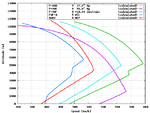Demetrious
Airman 1st Class
- 104
- Aug 22, 2007
It depends on what you mean by construction techniques. The P-40 didn't have the same NACA wing-foil section as the P-51 but generally speaking WWII fighters were of the same aluminium monocoque design as one another. The P-40 was certainly closely related to the P-51 in this respect.
The aerodynamicists-eye view of both planes however, was completely different; the P-51 was considerably more advanced, presumably that is what you meant.
Well, wikipedia says of it thus:
"It was a semi-modular design and thus easy to maintain in the field. It lacked innovations of the time, such as boosted ailerons or automatic leading edge slats, but it had a strong structure including a five-spar wing, which enabled P-40s to survive some mid-air collisions: both accidental impacts and intentional ramming attacks against enemy aircraft were occasionally recorded as victories by the Desert Air Force and Soviet Air Forces."
From what I've heard, the construction was overly "heavy," like the five-spar wing. Additionally, the older airfoil design was aerodynamically inferior to the NCA airfoil on the P-51, but it was also a lot sturdier (and heavier.) The P-51's airfoil was so thin that B model Mustangs didn't have electric gun chargers *and* jamming problems with their Brownings because the guns had to be installed at a funny angle.
That was my impression, at any rate.
I don't believe the P-40 possessed 'insane' structural strength, it was a hardy ship that could take some but a Hurricane pilot in the Battle of Britain lost two feet of his wing in an encounter. P-38s collided with telegraph poles. P-47s flew through treetops 'collecting firewood' in the mouth of their engine nacelles. All came home.
Yes, let's compare the P-40 to two of the hardiest aircraft of the war to dismiss it's durability as only average.
The final variant of the P-40 was the P-40Q and at 420-odd mph it still wasn't as fast as the P-51.
Who cares? It still had superior turn and roll characteristics, making it more manuverable then the P-51, and with 420mph speed, it's one crippling vice- low power- would be compensated for nicely. As reinreich just pointed out, a 30MPH advantage "won't win ACM" (though it does obviously have consequences.)
It would not and did not make commercial or tactical sense to introduce a competitor to the P-51 that wasn't as good. The P-40 already had truly realised its potential; at the time the 8th AF were escorting bomber streams into Europe, it was time for something new.
And where did I suggest that the P-40 should be introduced as a competitor to the P-51 in Europe? And what kind of crack would I have to be smoking to try, given that the P-51 was a long-range escort; a design unto itself? The P-40 wasn't even used on the Western Front.
As for commercial sense, the P-40 was $5,000 cheaper to build and more survivable, making it better at ground attack and arguably a better multi-role fighter (though that was true of the P-38 as well, which had an even better gun package and a longer range.) Of course, the P-40 was more manuverable then the P-38 as well, and the Merlin-engined models would not have had the crippling disability in the vertical.
But this is neither here nor there. I'm simply saying that the P-40 was an excellent airframe, and all it lacked was a good engine to give it the ability to really walk and talk the way it wanted to. I never suggested that the Army should have produced Merlin-engined P-40s instead of some other aircraft type, since by the time those engines were available, the Army had already built tons of P-38s, F6Fs, and other planes that had excellent performance characteristics of their own.
There might be something for suggesting that the Army could have saved themselves some trouble by tossing old Allison engines out of already-serving P-40s and installed new Merlins in them- an intelligent move at a time when any combat aircraft was desperately needed- but every Merlin was badly needed for Mustangs in the ETO, and the same for the new 1200 horsepower Allisons for P-38s in the PTO.

